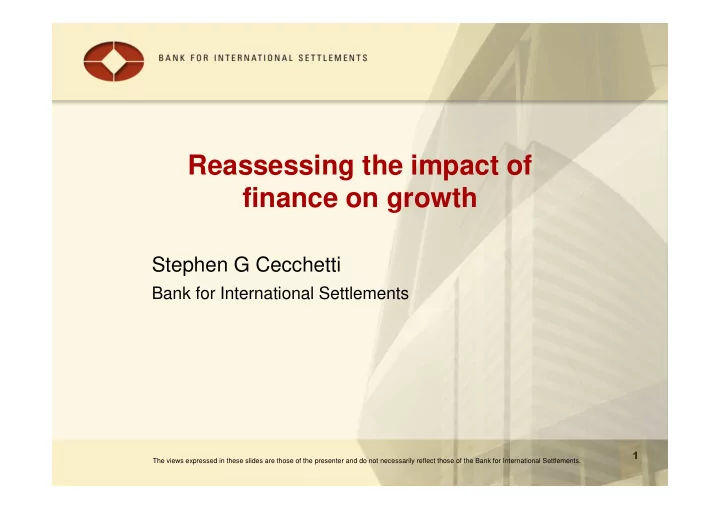

Reassessing the impact of finance on growth Stephen G Cecchetti Bank for International Settlements � � The views expressed in these slides are those of the presenter and do not necessarily reflect those of the Bank for International Settlements.
Financial development: a double-edged sword � Contributes to growth • Reduces transactions costs • Improves distribution of capital and risk � Detracts from growth • Competes for resources • Creates vulnerability • Can misallocate resources
When does the dark side of finance dominate? 1. Can the size of the financial sector be bad for productivity? 2. Does the growth rate of the financial sector become damaging? 3. Are some sectors more exposed than others?
When does the dark side of finance dominate? 1. Can the size of the financial sector be bad for productivity? Yes, when credit exceeds 100% of GDP.
When does the dark side of finance dominate? 1. Can the size of the financial sector be bad for productivity? Yes, when credit exceeds 100% of GDP. 2. Does the growth rate of the financial sector become damaging? Yes, a typical boom can reduce trend growth by ½ pp per year.
When does the dark side of finance dominate? 1. Can the size of the financial sector be bad for productivity? Yes, when credit exceeds 100% of GDP. 2. Does the growth rate of the financial sector become damaging? Yes, a typical boom can reduce trend growth by ½ pp per year. 3. Are some sectors more exposed than others? Yes, financially dependent and R&D intensive industries
Productivity growth & financial sector size � Size cuts both ways: • Fixed costs → increasing returns → bigger more efficient • But it diverts resources, reducing growth � The empirical questions: Can we find a turning point?
Productivity growth & financial sector size
Real growth & financial sector size � Turning point: private credit around 100% of GDP � Impact is large: • New Zealand: • Mid-1990s to 2006: Credit from 90% to 150% of GDP ⇒ Drag of nearly - 0.50 percentage points • Thailand: • Post-crisis: Credit from 150% to 95% of GDP ⇒ Benefit of + 0.50 percentage points • United States: • 2007: Credit >200% of GDP ⇒ Returning to 100% → + 1.50 percentage points �
Productivity Growth and Financial Sector Employment Controls: Investment to GDP, employment growth, openness to trade, initial labour productivity, country dummies. ��
Productivity Growth and Financial Sector Value Added Controls: Investment to GDP, employment growth, openness to trade, �� initial labour productivity, country dummies.
The size of the financial sector and growth � Turning point: • 3.2% of employment • 6.5% of value added � In 2008: • Employment: • Canada: 5.7% • Ireland: 4.5% • US: 4.1% • UK: 3.5% • Value added: • Ireland:10.4% • US: 7.7% ⇒ ⇒ Reduce value added from 7.7% to 6.5%: ⇒ ⇒ Productivity growth + 0.14 pp/yr ��
Productivity growth & financial sector growth � Finance consumes scarce resources � Competes for inelastically supply inputs � What is the relationship of trend growth to employment growth? ��
Productivity growth & financial sector growth ��
Productivity growth & financial sector growth � Typical boom: • Financial Sector Share in Total Employment grows +1.6 pp ⇒ 0.50 pp decline in trend productivity growth (sample average productivity growth rate: 1.3%) � From 2005 to 2009: • Productivity growth and financial sector share in employment growth: • Ireland: -2.7% and +4.1% • Spain: -1.4% and +1.4% • What if financial sector share in employment had been stable? • Ireland: -1.3% instead of -2.7% • Spain: -0.8% instead of -1.4% ��
Industry growth and financial sector growth � Financial sector growth affects sectors that compete for inputs • Finance is capital intensive: Financially dependent sectors, likely more affected. • Finance is skilled-labour intensive: R&D intensive sectors (most likely to be skilled-labour intensive) ��
1 6 1600 0 0 1 7 1700 0 0 Tobacco 1 7 1718 1 8 1 7 1719 Textile 1 9 Financial dependence in manufacturing industries 1 8 1800 0 0 1 9 1900 0 0 2 0 2000 0 0 R&D intensity in manufacturing industries 2 1 2100 0 0 2 1 2122 2 2 2 2 2200 0 0 Pharmaceuticals 2 3 2300 0 0 2 3 2325 2 5 2 4 2400 0 0 2 4 2401 0 1 2 4 2423 2 3 Computing machinery 2 5 2500 0 0 2 6 0 2600 0 2 7 2700 0 0 2 7 2728 2 8 2 8 2800 0 0 2 9 2900 0 0 3 0 3000 0 0 3 0 3033 3 3 3 1 3100 0 0 3 2 3200 0 0 3 3 0 3300 0 Medical instruments 3 4 3400 0 0 3 4 3435 3 5 3 5 3500 0 0 Aircraft 3 5 3510 1 0 3 5 3529 2 9 3 5 3530 3 0 3 6 3637 3 7 0 10 20 30 40 –50 –25 0 25 50 75 100 125 ��
Industry growth and financial sector growth � Main result: Financially dependent or R&D intensive industries are more harmed by financial sector booms. � Compute difference in productivity growth b/w: • Financially dependent or R&D intensive industry in a country w/ a financial sector boom • Financially independent or low R&D intensive industry in a country w/ a slow growing financial sector � Difference is 2 to 3 pp ! (av. of 2.1%, std.dev. of 4.3%) � Example: Spanish transport vs Swiss chemical industry: 4.5pp difference Almost all (4pp) due to Spain’s financial sector boom ��
Conclusions � Financial sector can be a drag on productivity growth • When private credit exceeds 100% of GDP • When the financial sector grows quickly • Financial booms are especially bad for • Financially dependent sectors • R&D intensive industries � More finance is definitely not always better ��
Thank you. ��
Recommend
More recommend